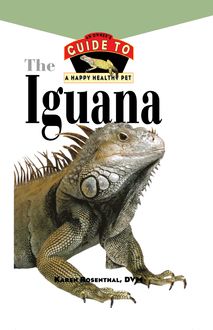Turtle , livre ebook
117
pages
English
Ebooks
2007
Vous pourrez modifier la taille du texte de cet ouvrage
Obtenez un accès à la bibliothèque pour le consulter en ligne En savoir plus
Découvre YouScribe en t'inscrivant gratuitement
Découvre YouScribe en t'inscrivant gratuitement
117
pages
English
Ebooks
2007
Vous pourrez modifier la taille du texte de cet ouvrage
Obtenez un accès à la bibliothèque pour le consulter en ligne En savoir plus
Publié par
Date de parution
17 juillet 2007
Nombre de lectures
0
EAN13
9780470127599
Langue
English
Poids de l'ouvrage
2 Mo
With their interesting shells and slow, deliberate demeanors, turtles are intriguing creatures. The more you know about turtles, the more fascinated you'll be as you watch your pet enjoy life in the slow lane. With colorful photos, charts, and tables, this guide covers the basics, including:
* Choosing your turtle--terrestrial or aquatic
*
Setting up a tank with the right environment
*
Essential equipment and supplies
*
Maintaining the proper temperature, lighting, and humidity
*
Feeding and caring for your turtle
Part I: All About Turtles.
Chapter 1: What Is a Turtle?
The Biology of Turtles and Tortoises.
Chelonian Anatomy.
Turtle Reproduction.
Chapter 2: Turtle History.
Reptile Evolution.
The Turtle’s Early Ancestors.
The Appearance of Modern Turtles.
Chelonian Ecology.
Chapter 3: The Best (and Worst) Turtles for Beginners.
The Best Turtles for Beginners.
The Worst Turtles for Beginners.
Part II: Caring for Your Turtle.
Chapter 4: Choosing Your Turtle.
Where to Get Your Turtle.
How to Choose a Healthy Turtle.
Quarantine.
If Things Don’t Work Out.
Chapter 5: Housing Your Turtle.
Terrestrial Turtles.
Aquatic Turtles.
Chapter 6: Feeding Your Turtle.
Terrestrial Turtles.
How to Feed Your Tortoise.
Aquatic Turtles.
Chapter 7: Keeping Your Turtle Healthy.
Finding a Veterinarian.
Salmonella.
Wounds.
Respiratory Infections.
Intestinal Infections.
Hibernation.
Parasites.
Cloacal Prolapse.
Visceral Gout.
Skin and Shell Problems.
Beaks and Claws.
The Calcium Balancing Act.
Part III: Turtles in Our World.
Chapter 8: Your Turtle’s Behavior.
How Smart Are Turtles?
Handling Your Turtle.
Holding Your Turtle.
Transporting a Turtle.
Kids and Turtles.
Chapter 9: Chelonian Conservation.
Herpetological Societies.
Captive Breeding.
Legal Protections.
Appendix: Learning More About Your Turtle.
Some Good Books.
Magazines.
Herpetological Societies and Associations.
Internet Resources.
Index.
Publié par
Date de parution
17 juillet 2007
Nombre de lectures
0
EAN13
9780470127599
Langue
English
Poids de l'ouvrage
2 Mo
This book is printed on acid-free paper.
Copyright © 2007 by Wiley Publishing, Inc., Hoboken, New Jersey. All rights reserved.
Howell Book House
Published by Wiley Publishing, Inc., Hoboken, New Jersey
No part of this publication may be reproduced, stored in a retrieval system or transmitted in any form or by any means, electronic, mechanical, photocopying, recording, scanning or otherwise, except as permitted under Sections 107 or 108 of the 1976 United States Copyright Act, without either the prior written permission of the Publisher, or authorization through payment of the appropriate per-copy fee to the Copyright Clearance Center, 222 Rosewood Drive, Danvers, MA 01923, (978) 750-8400, fax (978) 646-8600, or on the web at www.copyright.com . Requests to the Publisher for permission should be addressed to the Legal Department, Wiley Publishing, Inc., 10475 Crosspoint Blvd., Indianapolis, IN 46256, (317) 572-3447, fax (317) 572-4355, or online at http://www.wiley.com/go/permissions .
Wiley, the Wiley logo, Howell Book House, the Howell Book House logo, Your Happy Healthy Pet, and related trade dress are trademarks or registered trademarks of John Wiley & Sons, Inc. and/or its affiliates in the United States and other countries, and may not be used without written permission. All other trademarks are the property of their respective owners. Wiley Publishing, Inc. is not associated with any product or vendor mentioned in this book.
The publisher and the author make no representations or warranties with respect to the accuracy or completeness of the contents of this work and specifically disclaim all warranties, including without limitation warranties of fitness for a particular purpose. No warranty may be created or extended by sales or promotional materials. The advice and strategies contained herein may not be suitable for every situation. This work is sold with the understanding that the publisher is not engaged in rendering legal, accounting, or other professional services. If professional assistance is required, the services of a competent professional person should be sought. Neither the publisher nor the author shall be liable for damages arising here from. The fact that an organization or Website is referred to in this work as a citation and/or a potential source of further information does not mean that the author or the publisher endorses the information the organization or Website may provide or recommendations it may make. Further, readers should be aware that Internet Websites listed in this work may have changed or disappeared between when this work was written and when it is read.
For general information on our other products and services or to obtain technical support please contact our Customer Care Department within the U.S. at (800) 762-2974, outside the U.S. at (317) 572-3993 or fax (317) 572-4002.
Wiley also publishes its books in a variety of electronic formats. Some content that appears in print may not be available in electronic books. For more information about Wiley products, please visit our web site at www.wiley.com .
Library of Congress Cataloging-in-Publication Data:
Flank, Lenny.
Turtle : your happy healthy pet / Lenny Flank Jr. — 2nd ed.
p. cm.
Includes bibliographical references and index.
ISBN 978-0-470-03791-1 (cloth : alk. paper)
1. Turtles as pets. I. Title.
SF459.T8F53 2007
639.3’92—dc22
Printed in the United States of America
10 9 8 7 6 5 4 3 2 1
Book design by Melissa Auciello-Brogan
Cover design by Michael J. Freeland
Wiley Bicentennial Logo: Richard J. Pacifico
Book production by Wiley Publishing, Inc. Composition Services
About the Author
Lenny Flank Jr. is a longtime reptile keeper and enthusiast who has kept more than 100 different species over the past 25 years. He has written five books about reptiles, amphibians, and invertebrates, and has also written articles for Reptiles magazine and Reptile and Amphibian Hobbyist magazine.
For several years, Lenny did reptile rescue work, taking in unwanted snakes, turtles, and lizards, providing them with needed rehabilitation, and then adopting them out to good homes. As part of his education and public outreach efforts, he has given numerous educational talks and shows, using live reptiles, for school classrooms, Scout troops, and environmental groups.
Lenny lives in St Petersburg, Florida, where he shares his apartment with four snakes, two tarantulas, and a 10-year-old Musk turtle named Muffin.
About Howell Book House
Since 1961, Howell Book House has been America’s premier publisher of pet books. We’re dedicated to companion animals and the people who love them, and our books reflect that commitment. Our stable of authors—training experts, veterinarians, breeders, and other authorities—is second to none. And we’ve won more Maxwell Awards from the Dog Writers Association of America than any other publisher.
As we head toward the half-century mark, we’re more committed than ever to providing new and innovative books, along with the classics our readers have grown to love. This year, we’re launching several exciting new initiatives, including redesigning the Howell Book House logo and revamping our biggest pet series, Your Happy Healthy Pet TM , with bold new covers and updated content. From bringing home a new puppy to competing in advanced equestrian events, Howell has the titles that keep animal lovers coming back again and again.
Contents
Part I: All About Turtles
Chapter 1: What Is a Turtle?
The Biology of Turtles and Tortoises
Chelonian Anatomy
Turtle Reproduction
Chapter 2: Turtle History
Reptile Evolution
The Turtle’s Early Ancestors
The Appearance of Modern Turtles
Chelonian Ecology
Chapter 3: The Best (and Worst) Turtles for Beginners
The Best Turtles for Beginners
The Worst Turtles for Beginners
Part II: Caring for Your Turtle
Chapter 4: Choosing Your Turtle
Where to Get Your Turtle
How to Choose a Healthy Turtle
Quarantine
If Things Don’t Work Out
Chapter 5: Housing Your Turtle
Terrestrial Turtles
Aquatic Turtles
Chapter 6: Feeding Your Turtle
Terrestrial Turtles
How to Feed Your Tortoise
Aquatic Turtles
Chapter 7: Keeping Your Turtle Healthy
Finding a Veterinarian
Salmonella
Wounds
Respiratory Infections
Intestinal Infections
Hibernation
Parasites
Cloacal Prolapse
Visceral Gout
Skin and Shell Problems
Beaks and Claws
The Calcium Balancing Act
Part III: Turtles in Our World
Chapter 8: Your Turtle’s Behavior
How Smart Are Turtles?
Handling Your Turtle
Holding Your Turtle
Transporting a Turtle
Kids and Turtles
Chapter 9: Chelonian Conservation
Herpetological Societies
Captive Breeding
Legal Protections
Appendix: Learning More About Your Turtle
Some Good Books
Magazines
Herpetological Societies and Associations
Internet Resources
Index
Shopping List
You’ll need to do a bit of stocking up before you bring your turtle home. Below is a basic list of must-have supplies. For more detailed information on the selection of each item below, consult chapter 5 . For specific guidance on what food you’ll need, review chapter 6 .
For aquatic turtles:
Tank
Tank stand
Heat lamp for basking
Water heater
Thermometer
UV fluorescent light
External water filter
Rocks, log, or wood for basking
5-gallon bucket
Siphon hose
For terrestrial turtles:
Tank
Tank stand
Heat lamp for basking
Thermometer
UV fluorescent light
Substrate
Hide box
Water pan
Food dish
There are likely to be a few other items that you’re dying to pick up before bringing your turtle home. Use the following blanks to note any additional items you’ll be shopping for.
Pet Sitter’s Guide
Care Instructions
In the following blank lines, let the sitter know what to feed, how much, and when; what tasks need to be performed daily; and what weekly tasks they’ll be responsible for.
The Turtle
Chapter 1
What Is a Turtle?
T here is perhaps no more easily recognizable animal on earth than a turtle. Although there are lizards who look like snakes and salamanders who look like lizards, no other living creature looks remotely like a turtle. With their calm dispositions and brightly colored shells, turtles have been spared the enmity with which most other reptiles are usually regarded. Unlike lizards and snakes, which are almost universally reviled, turtles are usually considered charming and attractive creatures. Few people, even the most intense reptile haters, are afraid of turtles.
A few decades ago, every convenience store in the country was stocked with tiny, bright green baby turtles, usually found in a shallow water tray complete with a tiny plastic island and a palm tree. Unfortunately, few of the many thousands of people who purchased these little creatures had any real idea how to care for them, and most of them ended up in a watery grave after a few months. This dreadful mortality rate, combined with some exaggerated fears about the spread of disease by turtles, virtually put an end to the turtle pet trade.
Today, however, we have become more knowledgeable about the natural world and the role that various animals play in it—including reptiles—and turtles have once again become popular pets.
This book was written as a guide for the beginning turtle keeper, so new hobbyists can keep their pets happy and healthy. Although keeping turtles and tortoises in captivity is not difficult, there are a few potential problems that turtle keepers must be aware of, and a few rules and procedures that must be followed if these animals are to thrive in captivity.
Our knowledge of how to meet the needs of captive reptiles has expanded enormously in the past few years, and even though this book is aimed primarily at beginners, I hope that it can serve as a useful reference for more experienced turtle keepers, as well.
The Biology of Turtles and Tortoises
There are abou














